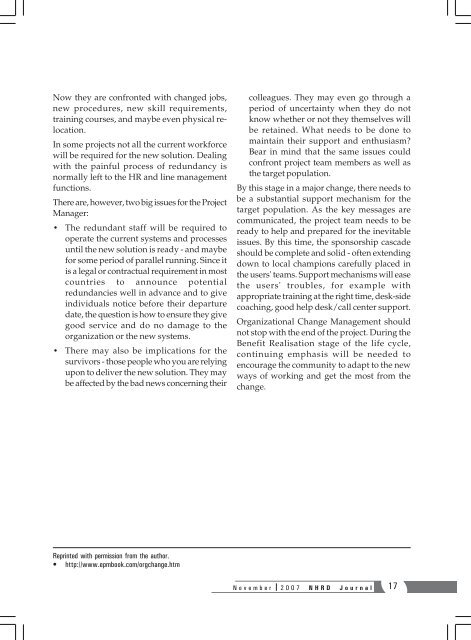NHRD Journal - National HRD Network
NHRD Journal - National HRD Network
NHRD Journal - National HRD Network
You also want an ePaper? Increase the reach of your titles
YUMPU automatically turns print PDFs into web optimized ePapers that Google loves.
Now they are confronted with changed jobs,<br />
new procedures, new skill requirements,<br />
training courses, and maybe even physical relocation.<br />
In some projects not all the current workforce<br />
will be required for the new solution. Dealing<br />
with the painful process of redundancy is<br />
normally left to the HR and line management<br />
functions.<br />
There are, however, two big issues for the Project<br />
Manager:<br />
• The redundant staff will be required to<br />
operate the current systems and processes<br />
until the new solution is ready - and maybe<br />
for some period of parallel running. Since it<br />
is a legal or contractual requirement in most<br />
countries to announce potential<br />
redundancies well in advance and to give<br />
individuals notice before their departure<br />
date, the question is how to ensure they give<br />
good service and do no damage to the<br />
organization or the new systems.<br />
• There may also be implications for the<br />
survivors - those people who you are relying<br />
upon to deliver the new solution. They may<br />
be affected by the bad news concerning their<br />
colleagues. They may even go through a<br />
period of uncertainty when they do not<br />
know whether or not they themselves will<br />
be retained. What needs to be done to<br />
maintain their support and enthusiasm?<br />
Bear in mind that the same issues could<br />
confront project team members as well as<br />
the target population.<br />
By this stage in a major change, there needs to<br />
be a substantial support mechanism for the<br />
target population. As the key messages are<br />
communicated, the project team needs to be<br />
ready to help and prepared for the inevitable<br />
issues. By this time, the sponsorship cascade<br />
should be complete and solid - often extending<br />
down to local champions carefully placed in<br />
the users' teams. Support mechanisms will ease<br />
the users' troubles, for example with<br />
appropriate training at the right time, desk-side<br />
coaching, good help desk/call center support.<br />
Organizational Change Management should<br />
not stop with the end of the project. During the<br />
Benefit Realisation stage of the life cycle,<br />
continuing emphasis will be needed to<br />
encourage the community to adapt to the new<br />
ways of working and get the most from the<br />
change.<br />
Reprinted with permission from the author.<br />
• http://www.epmbook.com/orgchange.htm<br />
November 2007 <strong>N<strong>HRD</strong></strong> <strong>Journal</strong> 17
















